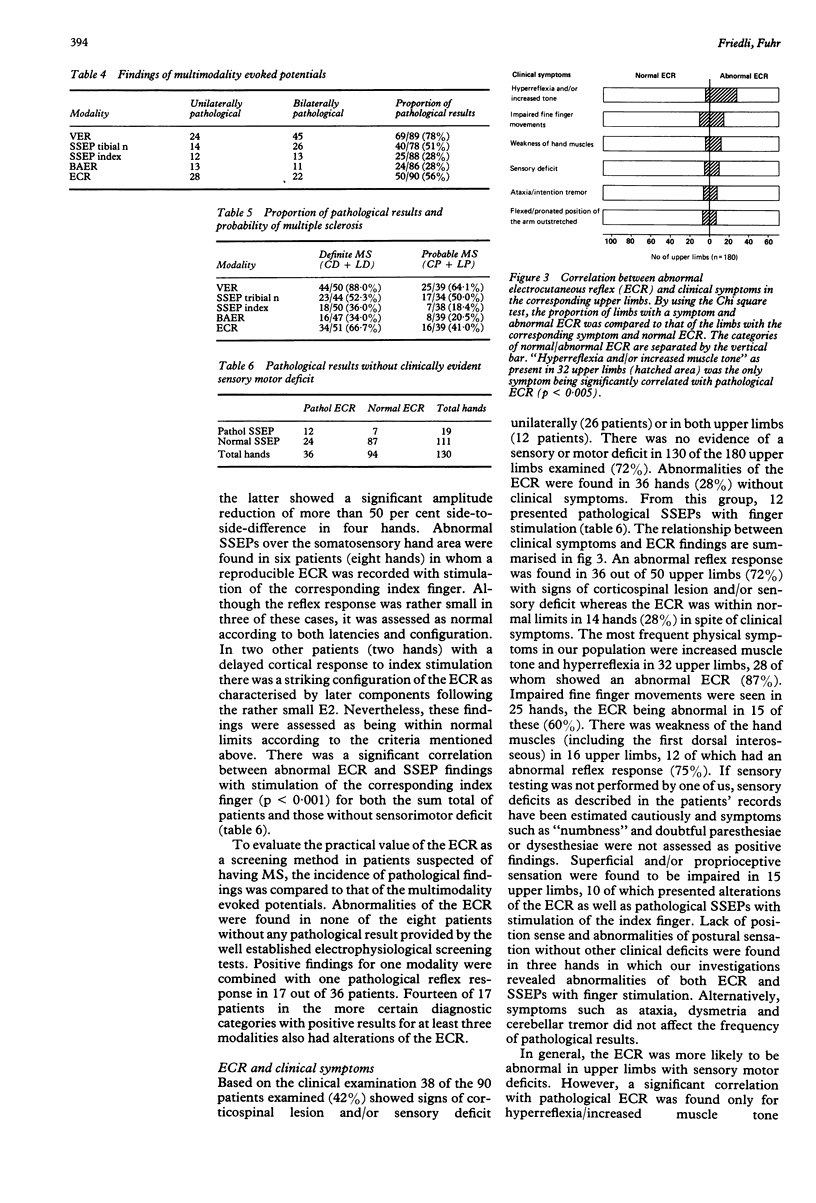Abstract
Electrical stimulation of the digital nerves of the index finger produces changes in the EMG signal during steady voluntary contraction of the first dorsal interosseous muscle. This electrocutaneous reflex (ECR) was studied in 90 patients classified into different categories according to diagnostic criteria for multiple sclerosis. In addition, pattern reversal visual evoked responses (VER), brainstem auditory evoked responses (BAER) as well as spinal and scalp recorded somatosensory evoked potentials (SSEP) were investigated by stimulating both the index finger and the posterior tibial nerve. The reflex response was altered uni- or bilaterally in 56 per cent of the patients and the abnormalities of the ECR were related to the categories of diagnostic probability. Pathological results were found in 28 per cent of the hands without clinical evidence of sensorimotor deficit. Although ECR abnormalities were often associated with clinical signs, significant correlation was found only with hyperreflexia and/or increased muscle tone in the corresponding upper limb. Pathological ECR were more common than pathological SSEPs with finger stimulation recorded under identical stimulus conditions. Fewer abnormalities were found by ECR testing than with VER, but the proportion of abnormal ECR was higher than that of BAER. ECR provides a valuable supplement to existing electrophysiological procedures for detecting lesions in the central nervous system.
Full text
PDF






Selected References
These references are in PubMed. This may not be the complete list of references from this article.
- Berardelli A., Hallett M., Kaufman C., Fine E., Berenberg W., Simon S. R. Stretch reflexes of triceps surae in normal man. J Neurol Neurosurg Psychiatry. 1982 Jun;45(6):513–525. doi: 10.1136/jnnp.45.6.513. [DOI] [PMC free article] [PubMed] [Google Scholar]
- Chiappa K. H., Harrison J. L., Brooks E. B., Young R. R. Brainstem auditory evoked responses in 200 patients with multiple sclerosis. Ann Neurol. 1980 Feb;7(2):135–143. doi: 10.1002/ana.410070208. [DOI] [PubMed] [Google Scholar]
- Conrad B., Aschoff J. C. Effects of voluntary isometric and isotonic activity on late transcortical reflex components in normal subjects and hemiparetic patients. Electroencephalogr Clin Neurophysiol. 1977 Jan;42(1):107–116. doi: 10.1016/0013-4694(77)90155-9. [DOI] [PubMed] [Google Scholar]
- Darton K., Lippold O. C., Shahani M., Shahani U. Long-latency spinal reflexes in humans. J Neurophysiol. 1985 Jun;53(6):1604–1618. doi: 10.1152/jn.1985.53.6.1604. [DOI] [PubMed] [Google Scholar]
- Deuschl G., Strahl K., Schenck E., Lücking C. H. The diagnostic significance of long-latency reflexes in multiple sclerosis. Electroencephalogr Clin Neurophysiol. 1988 Jul;70(1):56–61. doi: 10.1016/0013-4694(88)90194-0. [DOI] [PubMed] [Google Scholar]
- Fuhr P., Friedli W. G. Electrocutaneous reflexes in upper limbs--reliability and normal values in adults. Eur Neurol. 1987;27(4):231–238. doi: 10.1159/000116162. [DOI] [PubMed] [Google Scholar]
- Hagbarth K. E., Hägglund J. V., Wallin E. U., Young R. R. Grouped spindle and electromyographic responses to abrupt wrist extension movements in man. J Physiol. 1981 Mar;312:81–96. doi: 10.1113/jphysiol.1981.sp013617. [DOI] [PMC free article] [PubMed] [Google Scholar]
- Hays F. L., Webster A. J. Effects of cold, eating, efferent nerve stimulation and angiotensin on heart rate in sheep before and after autonomic blockade. J Physiol. 1971 Jul;216(1):21–38. doi: 10.1113/jphysiol.1971.sp009507. [DOI] [PMC free article] [PubMed] [Google Scholar]
- Hess C. W., Mills K. R., Murray N. M., Schriefer T. N. Magnetic brain stimulation: central motor conduction studies in multiple sclerosis. Ann Neurol. 1987 Dec;22(6):744–752. doi: 10.1002/ana.410220611. [DOI] [PubMed] [Google Scholar]
- Ingram D. A., Thompson A. J., Swash M. Central motor conduction in multiple sclerosis: evaluation of abnormalities revealed by transcutaneous magnetic stimulation of the brain. J Neurol Neurosurg Psychiatry. 1988 Apr;51(4):487–494. doi: 10.1136/jnnp.51.4.487. [DOI] [PMC free article] [PubMed] [Google Scholar]
- Jenner J. R., Stephens J. A. Cutaneous reflex responses and their central nervous pathways studied in man. J Physiol. 1982 Dec;333:405–419. doi: 10.1113/jphysiol.1982.sp014461. [DOI] [PMC free article] [PubMed] [Google Scholar]
- Marsden C. D., Merton P. A., Morton H. B., Adam J. The effect of lesions of the sensorimotor cortex and the capsular pathways on servo responses from the human long thumb flexor. Brain. 1977 Sep;100(3):503–526. doi: 10.1093/brain/100.3.503. [DOI] [PubMed] [Google Scholar]
- Marsden C. D., Merton P. A., Morton H. B., Adam J. The effect of posterior column lesions on servo responses from the human long thumb flexor. Brain. 1977 Mar;100(Pt 1):185–200. doi: 10.1093/brain/100.1.185. [DOI] [PubMed] [Google Scholar]
- Marsden C. D., Merton P. A., Morton H. B. Is the human stretch reflex cortical rather than spinal? Lancet. 1973 Apr 7;1(7806):759–761. doi: 10.1016/s0140-6736(73)92141-7. [DOI] [PubMed] [Google Scholar]
- Matthews P. B. Evidence from the use of vibration that the human long-latency stretch reflex depends upon spindle secondary afferents. J Physiol. 1984 Mar;348:383–415. doi: 10.1113/jphysiol.1984.sp015116. [DOI] [PMC free article] [PubMed] [Google Scholar]
- Mills K. R., Murray N. M. Corticospinal tract conduction time in multiple sclerosis. Ann Neurol. 1985 Nov;18(5):601–605. doi: 10.1002/ana.410180514. [DOI] [PubMed] [Google Scholar]
- Noth J., Podoll K., Friedemann H. H. Long-loop reflexes in small hand muscles studied in normal subjects and in patients with Huntington's disease. Brain. 1985 Mar;108(Pt 1):65–80. doi: 10.1093/brain/108.1.65. [DOI] [PubMed] [Google Scholar]
- Poser C. M., Paty D. W., Scheinberg L., McDonald W. I., Davis F. A., Ebers G. C., Johnson K. P., Sibley W. A., Silberberg D. H., Tourtellotte W. W. New diagnostic criteria for multiple sclerosis: guidelines for research protocols. Ann Neurol. 1983 Mar;13(3):227–231. doi: 10.1002/ana.410130302. [DOI] [PubMed] [Google Scholar]
- Robinson K., Rudge P. The stability of the auditory evoked potentials in normal man and patients with multiple sclerosis. J Neurol Sci. 1978 Mar;36(1):147–156. doi: 10.1016/0022-510x(78)90168-5. [DOI] [PubMed] [Google Scholar]
- Rowlandson P. H., Stephens J. A. Cutaneous reflex responses recorded in children with various neurological disorders. Dev Med Child Neurol. 1985 Aug;27(4):434–447. doi: 10.1111/j.1469-8749.1985.tb04566.x. [DOI] [PubMed] [Google Scholar]
- Wiesendanger M., Miles T. S. Ascending pathway of low-threshold muscle afferents to the cerebral cortex and its possible role in motor control. Physiol Rev. 1982 Oct;62(4 Pt 1):1234–1270. doi: 10.1152/physrev.1982.62.4.1234. [DOI] [PubMed] [Google Scholar]


